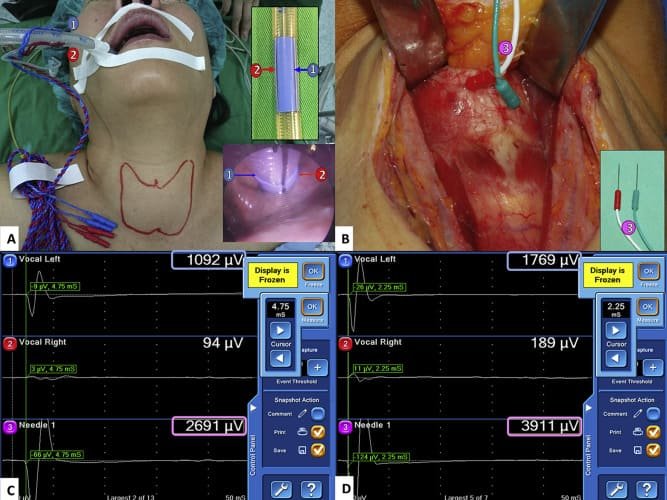Thyroid surgery is a common procedure for addressing thyroid disorders, and it involves intricate anatomy where the recurrent laryngeal nerve (RLN) is at risk of injury. Intraoperative Nerve Monitoring (IONM) is an optional technique that has gained attention for its potential to reduce the risk of RLN injury during these surgeries. In this comprehensive article, we delve into the nuances of IONM in thyroid surgery, from its techniques and equipment to its controversies and considerations.
Understanding IONM in Thyroid Surgery
What is Intraoperative Nerve Monitoring (IONM)?
IONM is a surgical adjunct that aims to minimize the incidence of RLN injury during thyroid surgery. This technique involves real-time monitoring of the nerves responsible for vocal cord function, primarily the RLN.
Techniques of Nerve Monitoring
Nerve Stimulation
- Intermittent Stimulation: During intermittent stimulation, a low-voltage electric current is delivered using a handheld probe. This approach is considered safer for maintaining vagal tone, but it may not detect impending nerve injury as early as continuous stimulation.
- Continuous Stimulation: Continuous stimulation involves placing an electrode on the ipsilateral vagus nerve. It has the advantage of potentially alerting the surgeon to an impending nerve injury earlier than intermittent stimulation. However, it comes with the risk of vagal neurapraxia or hemodynamic instability, especially if the electrode dislodges.
Vocal Fold Response
- Monitoring the vocal fold response to nerve stimulation is a key component of IONM. This is typically achieved by using a laryngeal surface electrode system attached to the endotracheal tube. The electrodes are positioned to enable contact with the vocal cords.
- During surgery, the vocal fold response to nerve stimulation is displayed on a nerve monitor as auditory or visual electromyographic (EMG) signals. Any changes in the pattern of EMG signals can indicate potential nerve irritation, which alerts the surgeon.
- It’s crucial to note that because vocal fold response is measured by EMG activities, only short-acting muscle relaxants, such as succinylcholine, should be used during the induction of anesthesia when IONM is employed. No paralytic agents should be used afterward to prevent interference with obtaining an EMG signal.
Controversies and Considerations
- Routine Use: The routine use of IONM in all thyroid surgeries is not supported by existing data. Its utility is more evident in high-risk procedures or those performed by low-volume surgeons.
- High-Risk Procedures: IONM may be particularly beneficial in high-risk scenarios, such as reoperations, surgeries for thyroid cancers, or retrosternal goiters.
- Surgeon Expertise: The effectiveness of IONM can be influenced by the surgeon’s experience and expertise in using this technology.
Intraoperative Nerve Monitoring is a valuable adjunct in thyroid surgery aimed at minimizing the risk of RLN injury. While it may not be necessary for all cases, it can provide an added layer of safety in high-risk procedures or when performed by less-experienced surgeons. However, its routine use remains a topic of ongoing research and debate. Surgeons should exercise vigilance and adhere to meticulous surgical techniques to avoid RLN injury, whether IONM is employed or not.
Conclusion
As the field of thyroid surgery continues to evolve, the role of IONM is likely to be further refined, and future studies may provide more conclusive evidence regarding its benefits and limitations. In the meantime, it remains a valuable tool in the armamentarium of thyroid surgeons, contributing to improved patient outcomes and safety.


